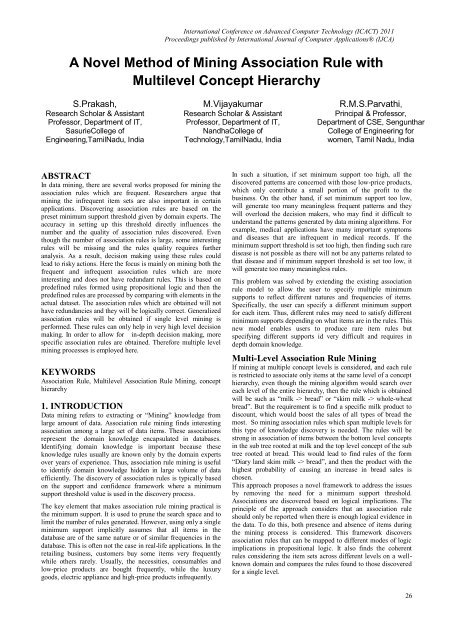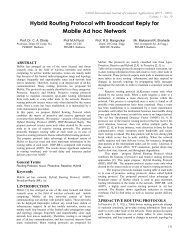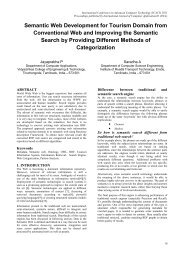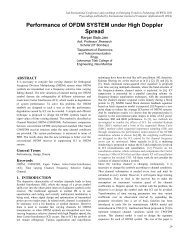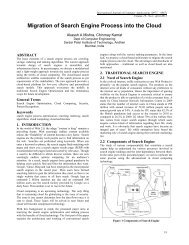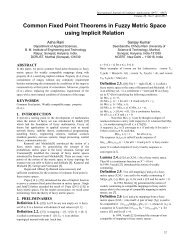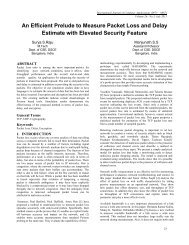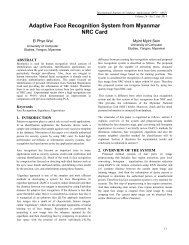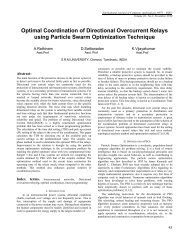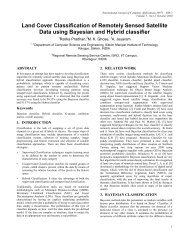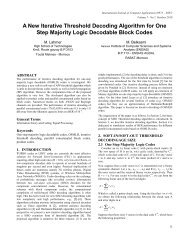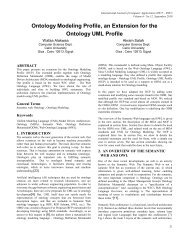A Novel Method of Mining Association Rule with Multilevel Concept ...
A Novel Method of Mining Association Rule with Multilevel Concept ...
A Novel Method of Mining Association Rule with Multilevel Concept ...
Create successful ePaper yourself
Turn your PDF publications into a flip-book with our unique Google optimized e-Paper software.
International Conference on Advanced Computer Technology (ICACT) 2011<br />
Proceedings published by International Journal <strong>of</strong> Computer Applications® (IJCA)<br />
A <strong>Novel</strong> <strong>Method</strong> <strong>of</strong> <strong>Mining</strong> <strong>Association</strong> <strong>Rule</strong> <strong>with</strong><br />
<strong>Multilevel</strong> <strong>Concept</strong> Hierarchy<br />
S.Prakash,<br />
Research Scholar & Assistant<br />
Pr<strong>of</strong>essor, Department <strong>of</strong> IT,<br />
SasurieCollege <strong>of</strong><br />
Engineering,TamilNadu, India<br />
M.Vijayakumar<br />
Research Scholar & Assistant<br />
Pr<strong>of</strong>essor, Department <strong>of</strong> IT,<br />
NandhaCollege <strong>of</strong><br />
Technology,TamilNadu, India<br />
R.M.S.Parvathi,<br />
Principal & Pr<strong>of</strong>essor,<br />
Department <strong>of</strong> CSE, Sengunthar<br />
College <strong>of</strong> Engineering for<br />
women, Tamil Nadu, India<br />
ABSTRACT<br />
In data mining, there are several works proposed for mining the<br />
association rules which are frequent. Researchers argue that<br />
mining the infrequent item sets are also important in certain<br />
applications. Discovering association rules are based on the<br />
preset minimum support threshold given by domain experts. The<br />
accuracy in setting up this threshold directly influences the<br />
number and the quality <strong>of</strong> association rules discovered. Even<br />
though the number <strong>of</strong> association rules is large, some interesting<br />
rules will be missing and the rules quality requires further<br />
analysis. As a result, decision making using these rules could<br />
lead to risky actions. Here the focus is mainly on mining both the<br />
frequent and infrequent association rules which are more<br />
interesting and does not have redundant rules. This is based on<br />
predefined rules formed using propositional logic and then the<br />
predefined rules are processed by comparing <strong>with</strong> elements in the<br />
actual dataset. The association rules which are obtained will not<br />
have redundancies and they will be logically correct. Generalized<br />
association rules will be obtained if single level mining is<br />
performed. These rules can only help in very high level decision<br />
making. In order to allow for in-depth decision making, more<br />
specific association rules are obtained. Therefore multiple level<br />
mining processes is employed here.<br />
KEYWORDS<br />
<strong>Association</strong> <strong>Rule</strong>, <strong>Multilevel</strong> <strong>Association</strong> <strong>Rule</strong> <strong>Mining</strong>, concept<br />
hierarchy<br />
1. INTRODUCTION<br />
Data mining refers to extracting or “<strong>Mining</strong>” knowledge from<br />
large amount <strong>of</strong> data. <strong>Association</strong> rule mining finds interesting<br />
association among a large set <strong>of</strong> data items. These associations<br />
represent the domain knowledge encapsulated in databases.<br />
Identifying domain knowledge is important because these<br />
knowledge rules usually are known only by the domain experts<br />
over years <strong>of</strong> experience. Thus, association rule mining is useful<br />
to identify domain knowledge hidden in large volume <strong>of</strong> data<br />
efficiently. The discovery <strong>of</strong> association rules is typically based<br />
on the support and confidence framework where a minimum<br />
support threshold value is used in the discovery process.<br />
The key element that makes association rule mining practical is<br />
the minimum support. It is used to prune the search space and to<br />
limit the number <strong>of</strong> rules generated. However, using only a single<br />
minimum support implicitly assumes that all items in the<br />
database are <strong>of</strong> the same nature or <strong>of</strong> similar frequencies in the<br />
database. This is <strong>of</strong>ten not the case in real-life applications. In the<br />
retailing business, customers buy some items very frequently<br />
while others rarely. Usually, the necessities, consumables and<br />
low-price products are bought frequently, while the luxury<br />
goods, electric appliance and high-price products infrequently.<br />
In such a situation, if set minimum support too high, all the<br />
discovered patterns are concerned <strong>with</strong> those low-price products,<br />
which only contribute a small portion <strong>of</strong> the pr<strong>of</strong>it to the<br />
business. On the other hand, if set minimum support too low,<br />
will generate too many meaningless frequent patterns and they<br />
will overload the decision makers, who may find it difficult to<br />
understand the patterns generated by data mining algorithms. For<br />
example, medical applications have many important symptoms<br />
and diseases that are infrequent in medical records. If the<br />
minimum support threshold is set too high, then finding such rare<br />
disease is not possible as there will not be any patterns related to<br />
that disease and if minimum support threshold is set too low, it<br />
will generate too many meaningless rules.<br />
This problem was solved by extending the existing association<br />
rule model to allow the user to specify multiple minimum<br />
supports to reflect different natures and frequencies <strong>of</strong> items.<br />
Specifically, the user can specify a different minimum support<br />
for each item. Thus, different rules may need to satisfy different<br />
minimum supports depending on what items are in the rules. This<br />
new model enables users to produce rare item rules but<br />
specifying different supports id very difficult and requires in<br />
depth domain knowledge.<br />
Multi-Level <strong>Association</strong> <strong>Rule</strong> <strong>Mining</strong><br />
If mining at multiple concept levels is considered, and each rule<br />
is restricted to associate only items at the same level <strong>of</strong> a concept<br />
hierarchy, even though the mining algorithm would search over<br />
each level <strong>of</strong> the entire hierarchy, then the rule which is obtained<br />
will be such as “milk -> bread” or “skim milk -> whole-wheat<br />
bread”. But the requirement is to find a specific milk product to<br />
discount, which would boost the sales <strong>of</strong> all types <strong>of</strong> bread the<br />
most. So mining association rules which span multiple levels for<br />
this type <strong>of</strong> knowledge discovery is needed. The rules will be<br />
strong in association <strong>of</strong> items between the bottom level concepts<br />
in the sub tree rooted at milk and the top level concept <strong>of</strong> the sub<br />
tree rooted at bread. This would lead to find rules <strong>of</strong> the form<br />
“Diary land skim milk -> bread”, and then the product <strong>with</strong> the<br />
highest probability <strong>of</strong> causing an increase in bread sales is<br />
chosen.<br />
This approach proposes a novel framework to address the issues<br />
by removing the need for a minimum support threshold.<br />
<strong>Association</strong>s are discovered based on logical implications. The<br />
principle <strong>of</strong> the approach considers that an association rule<br />
should only be reported when there is enough logical evidence in<br />
the data. To do this, both presence and absence <strong>of</strong> items during<br />
the mining process is considered. This framework discovers<br />
association rules that can be mapped to different modes <strong>of</strong> logic<br />
implications in propositional logic. It also finds the coherent<br />
rules considering the item sets across different levels on a wellknown<br />
domain and compares the rules found to those discovered<br />
for a single level.<br />
26
International Conference on Advanced Computer Technology (ICACT) 2011<br />
Proceedings published by International Journal <strong>of</strong> Computer Applications® (IJCA)<br />
2. LITERATURE SURVEY<br />
Using a minimum support threshold to identify frequent patterns<br />
assumes that an ideal minimum support threshold exists for<br />
frequent patterns, and that a user can identify this threshold<br />
accurately. Assuming that an ideal minimum support exists, it is<br />
unclear how to find this threshold [18]. This is largely due to the<br />
fact that there is no universal standard to define the notion <strong>of</strong><br />
being frequent enough and interesting. In this case one user’s<br />
understanding <strong>of</strong> an ideal strength value may be different from<br />
another user’s.<br />
A data set contains items that appear frequently while other items<br />
rarely occur. For example, in a retail fruit business, fruits are<br />
frequently observed but occasionally bread is also observed.<br />
Some items are rare in nature or infrequently found in a data set.<br />
These items are called rare items [11]. If a single minimum<br />
support threshold is used and is set high, those association rules<br />
involving rare items will not be discovered. Use <strong>of</strong> a single and<br />
lower minimum support threshold, on the other hand, would<br />
result in too many uninteresting association rules. This is called<br />
the rare item problem defined by Mannila. Instead <strong>of</strong><br />
preprocessing the transaction records, using multiple minimum<br />
thresholds called minimum item supports (MISs) . Nonetheless, a<br />
user needs toprovide an MIS threshold for each item which is<br />
difficult. The common aim, however, was to <strong>of</strong>fset heuristics<br />
when setting up a minimum support threshold. In all these<br />
approaches, we see that state-<strong>of</strong>-the-art association rule mining<br />
has drifted from the original idea <strong>of</strong> mining frequent patterns<br />
alone to considering other patterns as well. Using a minimum<br />
support threshold alone cannot identify these patterns<br />
specifically.<br />
Brin [6] shows that association rules discovered using a support<br />
and confidence framework may not be correlated in statistics.<br />
These association rules show item sets co-occurring together,<br />
<strong>with</strong> no implications among them. Scheffer highlights that in<br />
many cases, users who are interested in finding items that cooccur<br />
together are also interested in finding items which are<br />
connected in reality. Having a minimum support threshold does<br />
not guarantee the discovery <strong>of</strong> interesting association rules, as<br />
such rules may need to be further processed and quantified for<br />
interestingness.<br />
The usage <strong>of</strong> leverage and lift are good alternatives in mining<br />
association rules <strong>with</strong>out relying on pruning a minimum support<br />
threshold. The authors in mined arbitrarily top k number <strong>of</strong> rules<br />
using lift, leverage, and confidence <strong>with</strong>out using a preset<br />
minimum support threshold. The use <strong>of</strong> leverage and lift is also<br />
fundamental in designing a new measure <strong>of</strong> interestingness.<br />
Among such work, authors in [13] considered lift as also one <strong>of</strong><br />
the 12 interesting criteria to generate interesting rules called an<br />
informative rule set. Authors in devised a conditional<br />
probability-like measure <strong>of</strong> interestingness based on lift (termed<br />
as dependence) called the Conditional Probability Increment<br />
Ratio (CPIR) and used this to discover required interesting rules<br />
accordingly. Apart from the use <strong>of</strong> lift, leverage, and its derived<br />
measure <strong>of</strong> interestingness, measures <strong>of</strong> interestingness that<br />
consider a deviation from independence have also been used. The<br />
authors in [3] used Pearson’s correlation coefficient to search for<br />
both positive and negative association rules that have a strong<br />
correlation. This search algorithm found the strongest correlated<br />
rules, followed by rules <strong>with</strong> moderate and small strength values.<br />
The generalized framework is used to discover association rules<br />
that have the properties <strong>of</strong> propositional logic, and a specific<br />
framework (Coherent <strong>Rule</strong>s <strong>Mining</strong> Framework) <strong>with</strong> a basic<br />
algorithm to generate coherent rules from a given data set. The<br />
discovery <strong>of</strong> coherent rules is important because through<br />
coherent rules, a complete set <strong>of</strong> interesting association rules that<br />
are also implicational according to propositional logic can be<br />
discovered.<br />
Multi-level association rules are used to find the preferences for<br />
items that are not covered by the single-level association rules<br />
due to the data sparseness. Instead <strong>of</strong> considering single attribute<br />
for the rules multiple attributes are considered for obtaining more<br />
specific rules.<br />
Problem Definition<br />
The coherent rules are identified for the domain and based on the<br />
support value as well as the logical equivalences according to<br />
propositional logic the association rules are filtered out. The rules<br />
obtained include item sets that are frequently and infrequently<br />
observed in a set <strong>of</strong> transaction records for a single level. Here<br />
the generalized framework is obtained. The generalized<br />
framework will not help in-depth decision making as the rules<br />
obtained will be high level. Though the rules are logically<br />
correct, some scenarios occur in which the support is equal for<br />
both the rules that are coherent and here no proper decision can<br />
be made.<br />
3. METHODOLOGY<br />
The steps involved in the development <strong>of</strong> multilevel<br />
propositional logic based knowledge discovery involve the<br />
following phases:<br />
‣ Data Preprocessing<br />
‣ Propositional Logic for Coherent <strong>Rule</strong> Generation<br />
‣ Multi-Level concept hierarchy<br />
‣ Performance measure on generated rules<br />
Data Preprocessing<br />
Data preprocessing is a major step in data mining where all the<br />
unnecessary data in the datasets will be removed. Based on the<br />
nature <strong>of</strong> datasets taken for the experiment the preprocessing<br />
process will take place. If the dataset contains mostly missing<br />
attributes then those should be supplied by taking the previous<br />
observations.<br />
Figure 1Logic Pattern Discovery-useless attributes<br />
Figure 2 Logic Pattern Discovery-duplicate animals list<br />
In this work mainly removing the duplicate records and useless<br />
attributes were performed. Figure 1 shows the logical pattern<br />
discovery for useless attributes. These are done to minimize the<br />
27
International Conference on Advanced Computer Technology (ICACT) 2011<br />
Proceedings published by International Journal <strong>of</strong> Computer Applications® (IJCA)<br />
amount <strong>of</strong> data to be processed and also to remove duplicate<br />
records if any <strong>with</strong> different values which may be misleading.<br />
The useless attribute is nothing but the attribute which contains<br />
unique values. Figure 2 shows logic pattern discovery for<br />
duplicate animal list<br />
3.1 Propositional Logic for Coherent <strong>Rule</strong><br />
Generation<br />
The pseudo implications <strong>of</strong> equivalences are called coherent<br />
rules. Not all pseudo implications <strong>of</strong> equivalences can be created<br />
using item sets X and Y. If one pseudo implication <strong>of</strong><br />
equivalence can be created, then another pseudo implication <strong>of</strong><br />
equivalence also coexists. Two pseudo implications <strong>of</strong><br />
equivalences always exist as a pair because they are created<br />
based on the same conditions. Since they share the same<br />
conditions, two pseudo implications <strong>of</strong> equivalences, coexist<br />
having mapped to two logical equivalences. The result is a<br />
coherent rule that meets the same conditions.<br />
Coherent rules meet the necessary and sufficient conditions and<br />
have the truth table values <strong>of</strong> logical equivalence. The coherent<br />
rule consists <strong>of</strong> a pair <strong>of</strong> pseudo implications <strong>of</strong> equivalences that<br />
have higher support values compared to another two pseudo<br />
implications <strong>of</strong> equivalences. Coherent rules are defined based<br />
on logic. This improves the quality <strong>of</strong> association rules<br />
discovered because there are no missing association rules due to<br />
threshold setting. A user can discover all association rules that<br />
are logically correct <strong>with</strong>out having to know the domain<br />
knowledge. This is fundamental to various application domains.<br />
For example, one can discover the relations in a retail business<br />
<strong>with</strong>out having to study the possible relations among items. Any<br />
association rule that is not captured by coherent rules can be<br />
denied its importance. Figure 3 and 4 shows animal support list<br />
and rule list respectively<br />
patterns and strong association rules at the top-most concept<br />
level. With this user can find a set <strong>of</strong> pair-wised frequent items<br />
and a set <strong>of</strong> association rules at each level. The process repeats at<br />
even lower concept levels until no frequent patterns can be<br />
found. During multilevel association rule mining, the taxonomy<br />
information for each (grouped) item is encoded as a sequence <strong>of</strong><br />
digits in the transaction table. Repeated items (i.e., items <strong>with</strong> the<br />
same encoding) at any level will be treated as one item in one<br />
transaction.<br />
In the proposed concept hierarchy model, items may have<br />
different propositional logic and taxonomic relationships to<br />
discover the large item sets. The propositional logic for an item<br />
set is set as the combinatorial sub logic supports <strong>of</strong> the items<br />
contained in the item set, while the propositional logic for an<br />
item at a higher taxonomic concept is set as the minimum sub<br />
logics <strong>of</strong> the items belonging to it. Encoding scheme represents<br />
nodes in the predefined taxonomies for mining multilevel rules.<br />
Figure 5 shows the multiple attribute rule list.<br />
Nodes are encoded <strong>with</strong> respect to their positions in the hierarchy<br />
using sequences <strong>of</strong> numbers and the symbol. It then filters out<br />
unpromising item sets in two phases. In the first phase, an item<br />
group is removed if its occurring count is less than the<br />
propositional logic. In the second phase, the count <strong>of</strong> a<br />
propositional logic rules is checked to determine whether it is<br />
large. The proposed algorithm then finds all the large item sets<br />
for the given transactions by comparing the count <strong>of</strong> each item<br />
set <strong>with</strong> its combinatorial logic.<br />
3.3. Performance Measure On Generated<br />
<strong>Rule</strong>s<br />
The employed multilevel concept hierarchy based association<br />
rule mining using propositional logic is experimented <strong>with</strong><br />
synthetic data to evaluate the association rule and coherent rules<br />
<strong>with</strong>out having the domain knowledge. The results are also<br />
compared <strong>with</strong> logic based pattern discovery model <strong>with</strong> single<br />
level association rule mining model in terms <strong>of</strong> number <strong>of</strong> strong<br />
rules and weak rules generated. Effects <strong>of</strong> non sensitive rules are<br />
derived in both the existing and proposed schemes to show the<br />
efficiency <strong>of</strong> novel association rule mining process.<br />
Figure 3 Support List<br />
Figure 5 Multiple Attribute <strong>Rule</strong> List<br />
Figure 4 <strong>Rule</strong> list<br />
3.2 Multi-Level <strong>Concept</strong> Hierarchy<br />
In multilevel association rules mining, different propositional<br />
logic is used at different concept levels. Discover frequent<br />
The models works well <strong>with</strong> problems involving uncertainty in<br />
data relationships, which are represented by multilevel concepts<br />
for propositional logic rule derivation. The proposed mining<br />
algorithm can thus generate large item sets level by level and<br />
then derive concept multilevel association rules from transaction<br />
dataset. The results shown in the example implies that the<br />
proposed algorithm can derive the multiple-level association<br />
rules under different propositional logic in a simple and effective<br />
way.<br />
28
International Conference on Advanced Computer Technology (ICACT) 2011<br />
Proceedings published by International Journal <strong>of</strong> Computer Applications® (IJCA)<br />
4. SYSTEM IMPLEMENTATION<br />
The proposed system is very easy to implement. In general<br />
implementation is used to mean the process <strong>of</strong> converting a new<br />
or revised system design into an operational one. The<br />
implementation can be preceded <strong>with</strong> UCI data repository<br />
through Swing in java which supports numerous look and feels,<br />
including the ability to create own look and feel. The ability to<br />
create a custom look and feel is made easier. The main<br />
characteristics <strong>of</strong> the Swing toolkit are platform independent,<br />
customizable, extensible, configurable and lightweight.<br />
Comparison between single level association rules and multilevel<br />
association rule are shown in figure 6<br />
The implementation phase is less creative than system design. It<br />
is primarily concerned <strong>with</strong> user training, and file conversion.<br />
The system may be requiring extensive user training. The initial<br />
parameters <strong>of</strong> the management information system should be<br />
modifies as a result <strong>of</strong> a programming. The system developed is<br />
completely menu driven. Further a simple operating procedure is<br />
provided so that the user can understand the different functions<br />
clearly and quickly.<br />
Figure 6 single level association rules Vs <strong>Multilevel</strong><br />
association rule in terms <strong>of</strong> rule generation<br />
5. CONCLUSION<br />
The proposed multilevel association rule mining include item<br />
sets that are frequently and infrequently observed in a set <strong>of</strong><br />
transaction records. In addition to a complete set <strong>of</strong> rules being<br />
considered, these association rules can also be reasoned as<br />
logical implications because they inherit propositional logic<br />
properties. These association rules reduce the risks associated<br />
<strong>with</strong> using an incomplete set <strong>of</strong> association rules for decision<br />
making. The multilevel coherent rules mining framework is<br />
appreciated for its ability to discover rules that are both<br />
implicational and complete according to propositional logic from<br />
a given data set at various conceptual levels.<br />
This work can be enhanced by taking an unclassified dataset and<br />
perform classification before performing the experiment. But this<br />
classification should be appropriate in such a way that the rules<br />
obtained in the result should also be logically true when they are<br />
compared <strong>with</strong> the original dataset before classification.<br />
6. REFERENCES<br />
[1] Agrawal R., Imielinski T. and Swami A. (1993) “<strong>Mining</strong><br />
<strong>Association</strong> <strong>Rule</strong>s between Sets <strong>of</strong> Items in Large<br />
Databases” SIGMOD Record, vol. 22, pp. 207-216.<br />
[2] Alex TzeHiangSim, Maria Indrawan, SamarZutshi and<br />
BalaSrinivasan(2010) “Logic Based Pattern Discovery”<br />
IEEE Transactions on Knowledge and Data Engineering,<br />
VOL. 22, NO. 6, pp.798-811.<br />
[3] Antonie M.-L. and Zaýane O.R. (2004) “<strong>Mining</strong> Positive<br />
and Negative <strong>Association</strong> <strong>Rule</strong>s: An Approach for Confined<br />
<strong>Rule</strong>s” Proc. European Conf. Principles and Practice <strong>of</strong><br />
Knowledge Discovery in Databases (PKDD ’04), pp. 27-38.<br />
[4] Bing Liu, Minqing Hu, and Wynne Hsu (2000) “Multi-<br />
Level Organization and Summarization <strong>of</strong> the Discovered<br />
<strong>Rule</strong>s” Proc. ACM SIGKDD, Aug 20-23.<br />
[5] Blanchard J., Guillet F., Briand H. and Gras R. (2005)<br />
“Assessing <strong>Rule</strong> Interestingness <strong>with</strong> a Probabilistic<br />
Measure <strong>of</strong> Deviation from Equilibrium” Proc. 11th Int’l<br />
Symp. Applied Stochastic Models and Data Analysis<br />
(ASMDA ’05), pp. 191-200.<br />
[6] Brin S., Motwani R. and Silverstein C. (1997) “Beyond<br />
Market Baskets: Generalizing <strong>Association</strong> <strong>Rule</strong>s to<br />
Correlations” Proc. 1997 ACM SIGMOD, pp. 265-276.<br />
[7] Cao Longbing (2008) “Introduction to Domain Driven Data<br />
<strong>Mining</strong>,” Data <strong>Mining</strong> for Business Applications, Springer,<br />
pp. 3-10.<br />
[8] Choonho Kim and Juntae Kim (2003) ”A Recommendation<br />
Algorithm Using Multi-Level <strong>Association</strong> <strong>Rule</strong>s” Proc.<br />
IEEE/WIC Int’l Conf. on Web Intelligence page. 52.<br />
[9] Hellerstein J.L., Ma S., Perng C (2002) ”Discovering<br />
actionable patterns in event data” IBM Systems Journal, Vol<br />
41, NO 3.<br />
[10] KanimozhiSelvi C.S. and Tamilarasi A. (2009) ”An<br />
Automated <strong>Association</strong> <strong>Rule</strong> <strong>Mining</strong> Technique With<br />
Cumulative Support Thresholds”Int. J. Open Problems in<br />
Compt. Math, Vol. 2, No. 3.<br />
[11] Koh Y.S., Rountree N. and O’Keefe R.A (2006) “Finding<br />
Non-Coincidental Sporadic <strong>Rule</strong>s Using Apriori-Inverse”<br />
Int’l J. Data Warehousing and <strong>Mining</strong>, vol. 2, pp. 38-54.<br />
[12] Laszlo Szathmary, Amedeo Napoli and PetkoValtchev<br />
(2007) “Towards Rare Itemset <strong>Mining</strong>” Proc. <strong>of</strong> the 19th<br />
IEEE ICTAI, Vol. 1,pp. 305-312.<br />
[13] Li J. and Zhang Y. (2003) “Direct Interesting <strong>Rule</strong><br />
Generation” Proc. Third IEEE Int’l Conf. Data <strong>Mining</strong>, pp.<br />
155-162.<br />
29


